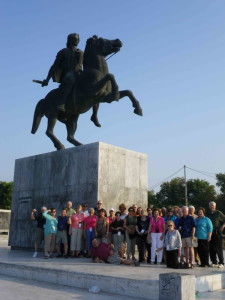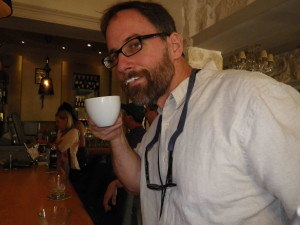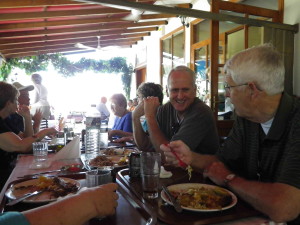Our day started off with another great breakfast (preceded of course by an inconvenient wake-up call at 6 AM). Amy and I had a little more trouble falling to sleep due to lingering affects of jet lag and air travel, but that is to be expected this early in the journey.
We boarded the bus and toured the ancient city of Thessaloniki which is not so ancient anymore. To be completely honest with you, it is more or less a sprawling litter of neo-facist architecture that is rather monotonous and bleak. It is of course the second largest city in Greece, so commerce is vibrant. We visited the statue of Alexander the Great, since Thessaloniki is the chief city of Macedonia. It is a rather dominating statue (to fit the man I suppose) but place in a rather gloomy spot alongside the harbor.
It turns out we left the city just in time. A few hours later protesters occupied city hall because of the Prime Minister’s visit this same day. According to our guide, Grecians are quite upset with the state of their economy – lower salaries, higher taxes and very high unemployment, especially for young adults. We had long since left the city so we knew nothing of the occupation until our guide heard it on the radio. It is interesting to discuss international politics and listen to the perception of others. It is a big world that is getting smaller every day.
Just outside of the city we approached Beroea, where Paul visited a synagogue where we read, “for they welcomed the message very eagerly and examined the scriptures every day to see whether these things were so. Many of them therefore believed, including not a few Greek women and men of high standing.” (Acts 17:11-12) All that is remaining today are three stone steps of that first century synagogue. The are shrouded with recent mosaics commemorating the event.
Before leaving Beroea we all scattered to find places for “coffee-in, coffee-out.”
Our next stop brought us to the small, quiet, but quite delightful town of Vergina, where we visited a museum built above the excavations of the tomb of Phillip II, father of Alexander the Great. The museum was well-done, documenting both the excavation as well as details regarding the entombment of this great historical figure. We were able to look in and see the outside of the actual tomb as well as view the many artifacts now carefully preserved.
Travels like this one are wonderfully punctuated with meals, oftentimes with me asking, before I have finished my plate, “so, what time are we eating again?” We ate in Vergina and I enjoyed a plate of traditional mousaka. Can you believe I have been here several days and have not had the chance yet to eat a gyro? I did see a vendor but by this time I had just finished lunch.
We had about a 2 ½ hour before our next stop, which was planned at the last minute. Our guide asked of me if I thought our group would like to travel to an icon workshop founded by an Orthodox priest. Of course! So we drove an extra fifteen minutes and were provided with a memory of a lifetime. The sister of the priest met us and took us to this very modest workshop where she explained the “craft” of making icons – from wood selection to the curing of the canvas. This family has provided icons for the Vatican for Pope Paul John as well as Pope Benedictine when he came to Greece to meet with Orthodox Arch Bishop. Most of us walked away with hand-painted icons that are extremely hard to come by in Augusta, GA. One of the artists signed each of our icons, which took her nearly a half hour away from “usual” duties. When I boarded the bus the conversation was robust with enthusiasm for this great opportunity. The guide presented me an icon of John the Baptist baptizing Jesus. She thought that was fitting for a Baptist pastor. While I am no John (well, I have a beard and I will eat most anything crawling) the gift was beautiful and touching.
Following the “excursus” on Thessalonika, I have added a similar column for icons.
Our hotel, while not as new or “modern” as our last one, is rich in character – and no, that is not code for a dump. It is surrounded by beautiful mountains and while the rooms are simpler, they are clean and cozy. Most importantly the food is great. They even had a “build-your-own-gyro” bar! Life is good.
The hour is late (after 10 PM here) and the morning wake up call will come soon. I am glad Amy is here with me to share this great experience. I do miss you all.
Grace and peace, Greg
Excursus on Thessalonika:
In the Bible we read of Thessalonians in Acts 17:1-9; and Paul’s two Epistles to Thessalonians
Thessaloniki (also known as Thessalonika, Salonica, Solun, and Selanik) is the second-largest city in Greece, located 320 miles north of Athens. Thessaloniki may be second to Athens in size and political importance, but in popular songs, Thessaloniki is celebrated as “the most blessed of cities” and “the city whose praises are sung.” Thessaloniki is also very popular with visitors, thanks to its beautiful sea views, tree-lined streets, many museums, Turkish-influenced food, thriving modern culture and ancient Byzantine churches. It also makes an excellent base for exploring Mount Athos and the historical sites of Philip II of Macedon and Alexander the Great.
Thessaloniki has a long and fascinating history. Founded in 315 BC and named for Alexander the Great’s sister, Thessaloniki became an important Roman trading center and an early center of Christianity. The Apostle Paul preached here in the first century and many churches were built in the Byzantine era. In the Middle Ages, Thessaloniki was repeatedly invaded: it was successively occupied by the Slavs, the Saracens, Crusaders, and Ottoman Turks until its return to Greece in 1913. The city suffered a major fire in 1917 and was occupied again in the 1940s by the Nazis. Today, it has a population of over 300,000 and is known for its lively nightlife.” (From Sacred Destinations)
Thessalonica was part of Paul’s second missionary journey.
1 Thessalonians is considered to be the oldest book in the NT, about 51 AD and it was written following a questionable report from Timothy.
His audience appears Gentile since there are no references to Mosaic law, Judaism or any OT person, institution or event (Moses, the temple, sacrifice).
Basically this letter gives us insight to Paul’s missionary activity and his commitment to the congregations he has helped to found and nurture.
It is textually self-evident that Paul viewed the Second Coming as immanent. Therefore how to live, behave and relate was consequential.
Greek Beliefs concerning afterlife, esp. in Macedonia:
- Underworld – hades or realm of Hades.
- Islands of the Blessed
- Spirits semi-exist at the grave
- Immortality of the soul
This letter reflects confusion about death.
as well as Hagia Sophia – 8th century church, and a Roman rotunda (2nd century; 3rd century Christian apse)
Excursus on Orthodox Icons:
The word icon comes from the Greek “εικoνογραφία”, which means an image in writing. The term is brandished about loosely and can refer, technically, to all Christian Art. For our purposes we will look at what is often called “Byzantine Icons” – icons of the late Roman period to present day.
Icons have been part of Orthodox worship and mysticism since the days of the Roman Empire when Constantine converted to Christianity (312 C.E.). The are largely maintained in the Eastern Orthodox traditions including Russia, Serbia and of course Greece. Through most of the 20th century the former Soviet Union outlawed icons.
Colossians 1:15-17 He is the image of the invisible God, the firstborn of all creation; 16 for in him all things in heaven and on earth were created, things visible and invisible, whether thrones or dominions or rulers or powers– all things have been created through him and for him. 17 He himself is before all things, and in him all things hold together.
An icon is way to make the invisible God visible through Christ (Colossians 1:15), therefore iconographers (icon painters) are themselves theologians. The icon is a way to make plain the doctrine of incarnation. An icon is not art for art’s sake or merely a portrayal of a biblical scene. An icon is to have an “other-worldly” character; transcendent and mystical.
The emphasis of an icon is holiness, not representation of humanity.
It is art for worship; not art to worship. There is a difference between venerate (as many do with the American flag) and worship, of whom only God is deserving.
Similar to stain glass, icons have served the function as scripture to the illiterate.
Icons are typically characterized with bright colors and gold backgrounds. Everything about an icon is symbolic. For example the ears of Christ are often portrayed large but his mouth small, indicating One who hears all, but speaks only wisdom.
An icon depicts height and width but not the “third dimension” of depth. This may go back to Greece’s pagan background where statuary created sensuous space. The two dimensionality of an icon painting is to invite the viewer to “see” beyond what the eye can see. It is said that an icon is a “window to heaven.”
In the icons of Eastern Orthodoxy, and of the Early Medieval West, very little room is made for artistic license. Almost everything within the image has a symbolic aspect. Christ, the saints, and the angels all have halos. Angels (and often John the Baptist) have wings because they are messengers. Figures have consistent facial appearances, hold attributes personal to them, and use a few conventional poses.
Color too plays an important role. Gold represents the radiance of Heaven; red, divine life. Blue is the color of human life, white is the uncreated essence of God, only used for resurrection and transfiguration of Christ.
If you look at icons of Jesus and Mary: Jesus wears red undergarment with a blue outer garment (God become Human) and Mary wears a blue undergarment with a red over-garment (human was granted gifts by God), thus the doctrine of deification is conveyed by icons. Letters are symbols too. Most icons incorporate some calligraphic text naming the person or event depicted. Even this is often presented in a stylized manner.




Recent Comments